Business Communication Report: Tesco's Information Analysis
VerifiedAdded on 2020/06/06
|9
|2817
|98
Report
AI Summary
This report provides a comprehensive analysis of business communication, detailing various types of business information, their sources, and intended purposes. It explores both internal and external corporate communication strategies, with a specific focus on the methods employed by Tesco. The report further delves into legal and ethical considerations surrounding the use of business information, including the Data Protection Act 1998, Freedom of Information Act 2000, and Computer Misuse Act 1990. It also examines operational issues related to information management and contrasts electronic and non-electronic communication methods. The report uses a variety of examples to illustrate the concepts discussed, providing a practical understanding of how businesses communicate both internally and externally.
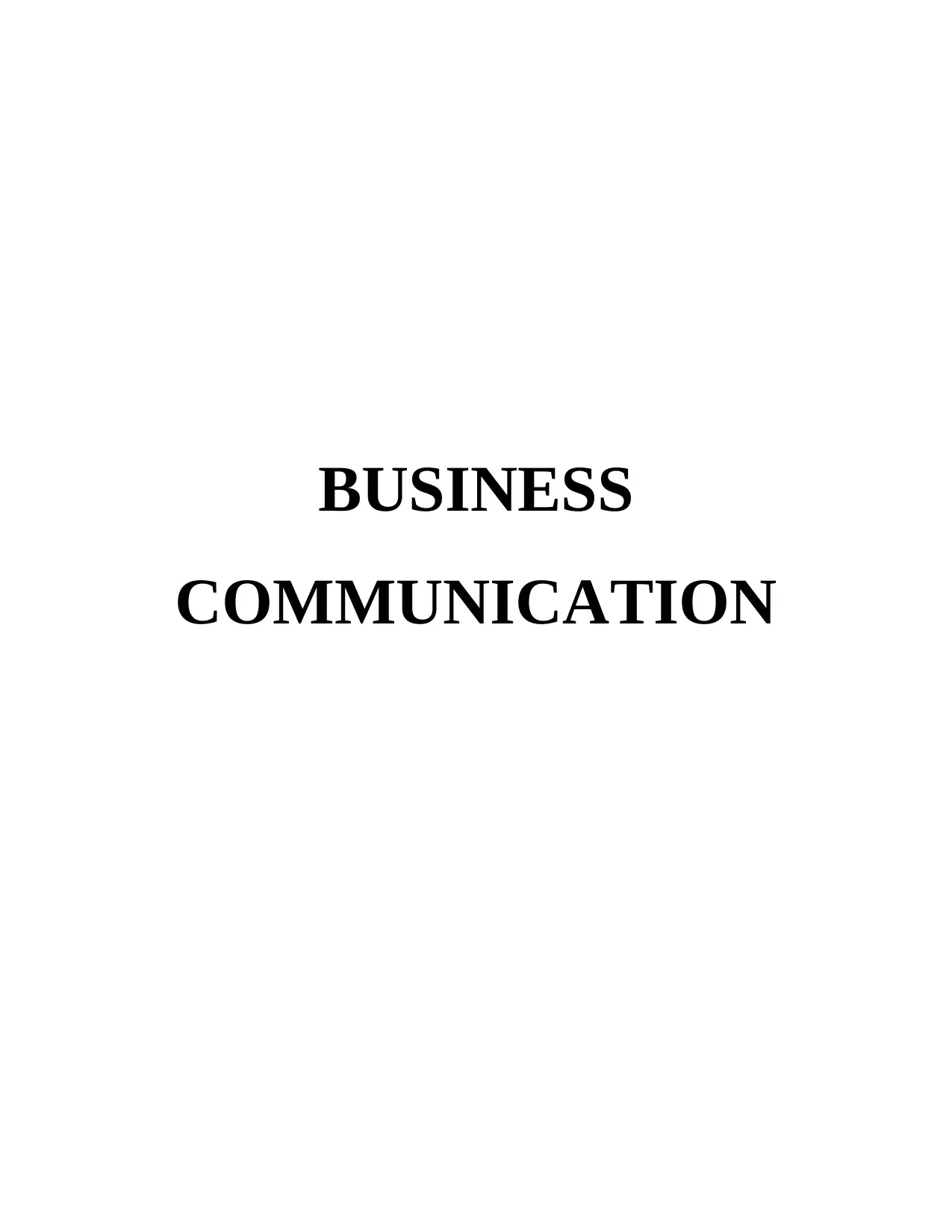
BUSINESS
COMMUNICATION
COMMUNICATION
Paraphrase This Document
Need a fresh take? Get an instant paraphrase of this document with our AI Paraphraser
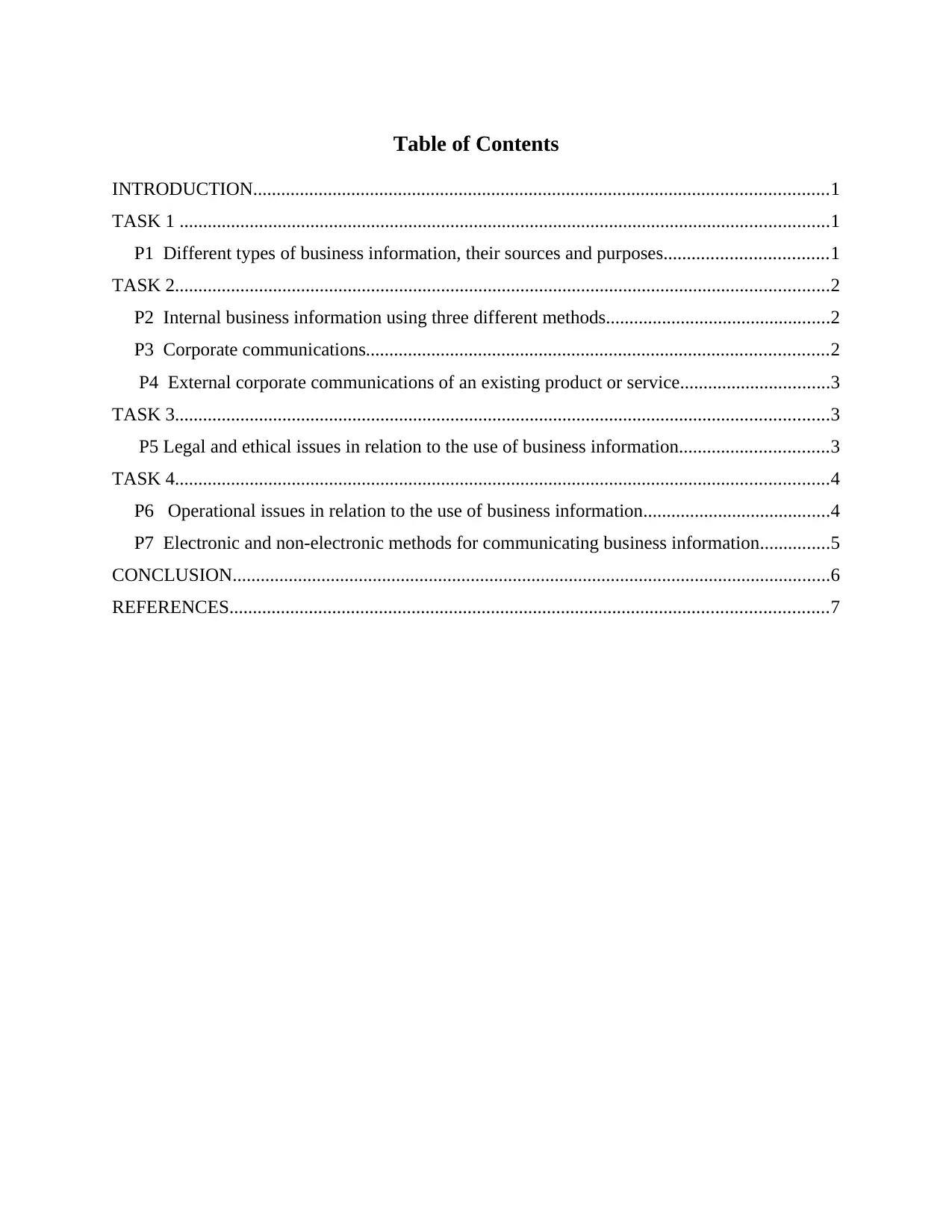
Table of Contents
INTRODUCTION...........................................................................................................................1
TASK 1 ...........................................................................................................................................1
P1 Different types of business information, their sources and purposes...................................1
TASK 2............................................................................................................................................2
P2 Internal business information using three different methods................................................2
P3 Corporate communications...................................................................................................2
P4 External corporate communications of an existing product or service................................3
TASK 3............................................................................................................................................3
P5 Legal and ethical issues in relation to the use of business information................................3
TASK 4............................................................................................................................................4
P6 Operational issues in relation to the use of business information........................................4
P7 Electronic and non-electronic methods for communicating business information...............5
CONCLUSION................................................................................................................................6
REFERENCES................................................................................................................................7
INTRODUCTION...........................................................................................................................1
TASK 1 ...........................................................................................................................................1
P1 Different types of business information, their sources and purposes...................................1
TASK 2............................................................................................................................................2
P2 Internal business information using three different methods................................................2
P3 Corporate communications...................................................................................................2
P4 External corporate communications of an existing product or service................................3
TASK 3............................................................................................................................................3
P5 Legal and ethical issues in relation to the use of business information................................3
TASK 4............................................................................................................................................4
P6 Operational issues in relation to the use of business information........................................4
P7 Electronic and non-electronic methods for communicating business information...............5
CONCLUSION................................................................................................................................6
REFERENCES................................................................................................................................7

INTRODUCTION
Business communication is information sharing between people within and outside an
organization that is performed for the commercial benefit of the organization. It can also be
defined as relaying of information within a business by its people (Ulrich and Sarasin, 2012). A
two way information sharing process which involves one party sending a message that is easily
understood by the receiving party. Effective communication by business managers facilitates
information sharing between company employees and can substantially contribute to its
commercial success. The present report is based on the business communication. The report is
explaining the different types of business information, their sources and purposes.
TASK 1
P1 Different types of business information, their sources and purposes
Verbal information is literally face to face which is seen as the best way to communicate.
This way there is less scope for misunderstanding and it allows for verbal and non-verbal
messages. Written Written information is the use of physical symbols to represent words. Words
are sounds that make up speech. Other forms of physical representation, such as diagrams,
graphs and charts are also types of visual representation . On screen On screen information may
be produced on-screen. This can be seen in multimedia TV and CD-ROMs that combine text,
graphics, animation, audio and video. Multimedia Multimedia information can be text, graphics,
audio, animation, video, data and many more. It is media and content that uses a combination of
different content forms (Tian and Borges, 2011).
The business information need of this to provide more information of what the
organisation is about and what they are going to do in the future. This is can be set out in many
ways for example written information, Verbal information, Multimedia information and Web-
based information. These groups of providing information can be used to explain their
organisation is about such as Tesco plc.
The purpose of on screen information is that it provides information on screen such as the
television, computer, DVD, etc. for consumers to be notified about any sales in organisation
which is advertised which is advertised on the television to announce special deals. For example
the picture of the advert that is offering 3 for £10 for salmon. This is the reason why Tesco plc
will use on screen to give information about things that corporation is providing in their
1
Business communication is information sharing between people within and outside an
organization that is performed for the commercial benefit of the organization. It can also be
defined as relaying of information within a business by its people (Ulrich and Sarasin, 2012). A
two way information sharing process which involves one party sending a message that is easily
understood by the receiving party. Effective communication by business managers facilitates
information sharing between company employees and can substantially contribute to its
commercial success. The present report is based on the business communication. The report is
explaining the different types of business information, their sources and purposes.
TASK 1
P1 Different types of business information, their sources and purposes
Verbal information is literally face to face which is seen as the best way to communicate.
This way there is less scope for misunderstanding and it allows for verbal and non-verbal
messages. Written Written information is the use of physical symbols to represent words. Words
are sounds that make up speech. Other forms of physical representation, such as diagrams,
graphs and charts are also types of visual representation . On screen On screen information may
be produced on-screen. This can be seen in multimedia TV and CD-ROMs that combine text,
graphics, animation, audio and video. Multimedia Multimedia information can be text, graphics,
audio, animation, video, data and many more. It is media and content that uses a combination of
different content forms (Tian and Borges, 2011).
The business information need of this to provide more information of what the
organisation is about and what they are going to do in the future. This is can be set out in many
ways for example written information, Verbal information, Multimedia information and Web-
based information. These groups of providing information can be used to explain their
organisation is about such as Tesco plc.
The purpose of on screen information is that it provides information on screen such as the
television, computer, DVD, etc. for consumers to be notified about any sales in organisation
which is advertised which is advertised on the television to announce special deals. For example
the picture of the advert that is offering 3 for £10 for salmon. This is the reason why Tesco plc
will use on screen to give information about things that corporation is providing in their
1
⊘ This is a preview!⊘
Do you want full access?
Subscribe today to unlock all pages.

Trusted by 1+ million students worldwide
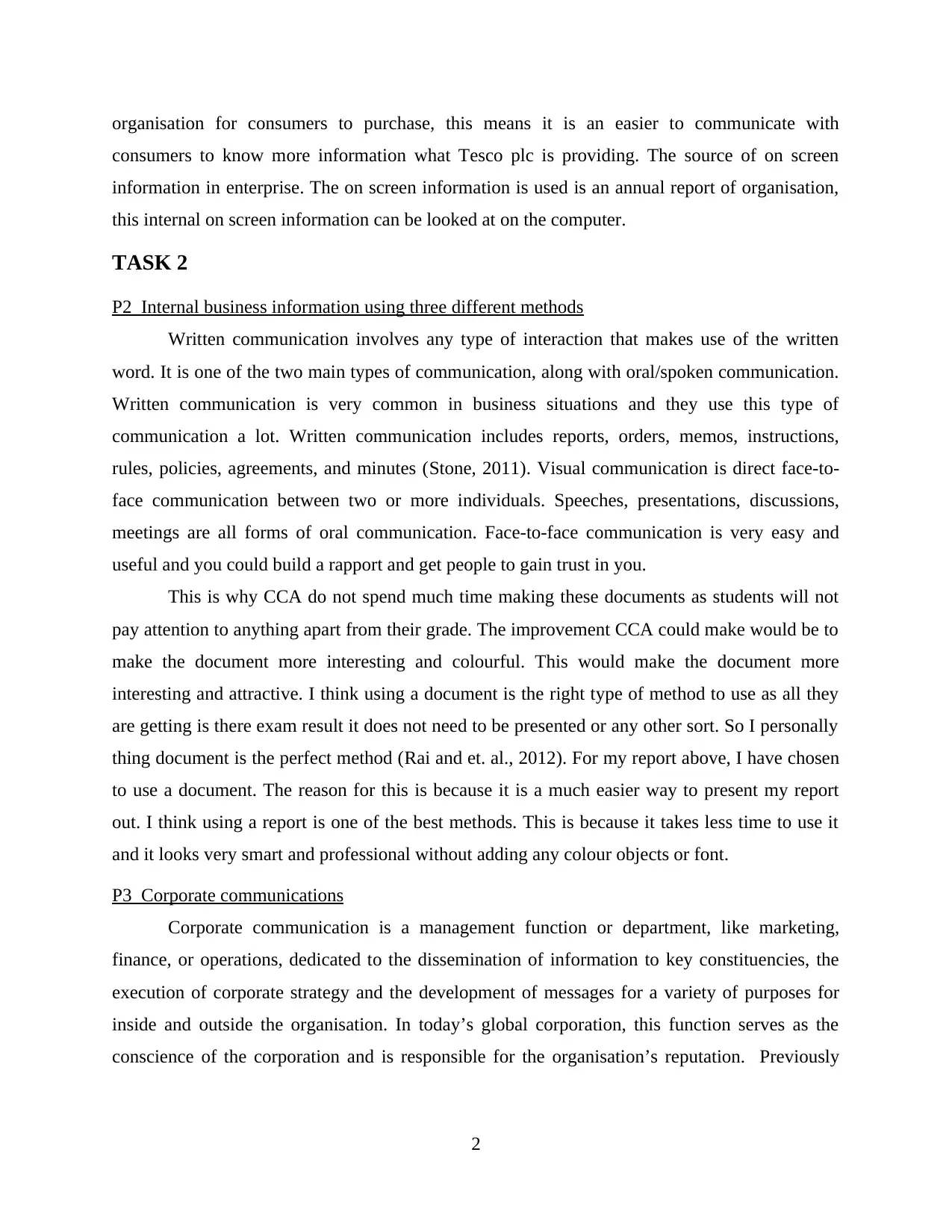
organisation for consumers to purchase, this means it is an easier to communicate with
consumers to know more information what Tesco plc is providing. The source of on screen
information in enterprise. The on screen information is used is an annual report of organisation,
this internal on screen information can be looked at on the computer.
TASK 2
P2 Internal business information using three different methods
Written communication involves any type of interaction that makes use of the written
word. It is one of the two main types of communication, along with oral/spoken communication.
Written communication is very common in business situations and they use this type of
communication a lot. Written communication includes reports, orders, memos, instructions,
rules, policies, agreements, and minutes (Stone, 2011). Visual communication is direct face-to-
face communication between two or more individuals. Speeches, presentations, discussions,
meetings are all forms of oral communication. Face-to-face communication is very easy and
useful and you could build a rapport and get people to gain trust in you.
This is why CCA do not spend much time making these documents as students will not
pay attention to anything apart from their grade. The improvement CCA could make would be to
make the document more interesting and colourful. This would make the document more
interesting and attractive. I think using a document is the right type of method to use as all they
are getting is there exam result it does not need to be presented or any other sort. So I personally
thing document is the perfect method (Rai and et. al., 2012). For my report above, I have chosen
to use a document. The reason for this is because it is a much easier way to present my report
out. I think using a report is one of the best methods. This is because it takes less time to use it
and it looks very smart and professional without adding any colour objects or font.
P3 Corporate communications
Corporate communication is a management function or department, like marketing,
finance, or operations, dedicated to the dissemination of information to key constituencies, the
execution of corporate strategy and the development of messages for a variety of purposes for
inside and outside the organisation. In today’s global corporation, this function serves as the
conscience of the corporation and is responsible for the organisation’s reputation. Previously
2
consumers to know more information what Tesco plc is providing. The source of on screen
information in enterprise. The on screen information is used is an annual report of organisation,
this internal on screen information can be looked at on the computer.
TASK 2
P2 Internal business information using three different methods
Written communication involves any type of interaction that makes use of the written
word. It is one of the two main types of communication, along with oral/spoken communication.
Written communication is very common in business situations and they use this type of
communication a lot. Written communication includes reports, orders, memos, instructions,
rules, policies, agreements, and minutes (Stone, 2011). Visual communication is direct face-to-
face communication between two or more individuals. Speeches, presentations, discussions,
meetings are all forms of oral communication. Face-to-face communication is very easy and
useful and you could build a rapport and get people to gain trust in you.
This is why CCA do not spend much time making these documents as students will not
pay attention to anything apart from their grade. The improvement CCA could make would be to
make the document more interesting and colourful. This would make the document more
interesting and attractive. I think using a document is the right type of method to use as all they
are getting is there exam result it does not need to be presented or any other sort. So I personally
thing document is the perfect method (Rai and et. al., 2012). For my report above, I have chosen
to use a document. The reason for this is because it is a much easier way to present my report
out. I think using a report is one of the best methods. This is because it takes less time to use it
and it looks very smart and professional without adding any colour objects or font.
P3 Corporate communications
Corporate communication is a management function or department, like marketing,
finance, or operations, dedicated to the dissemination of information to key constituencies, the
execution of corporate strategy and the development of messages for a variety of purposes for
inside and outside the organisation. In today’s global corporation, this function serves as the
conscience of the corporation and is responsible for the organisation’s reputation. Previously
2
Paraphrase This Document
Need a fresh take? Get an instant paraphrase of this document with our AI Paraphraser
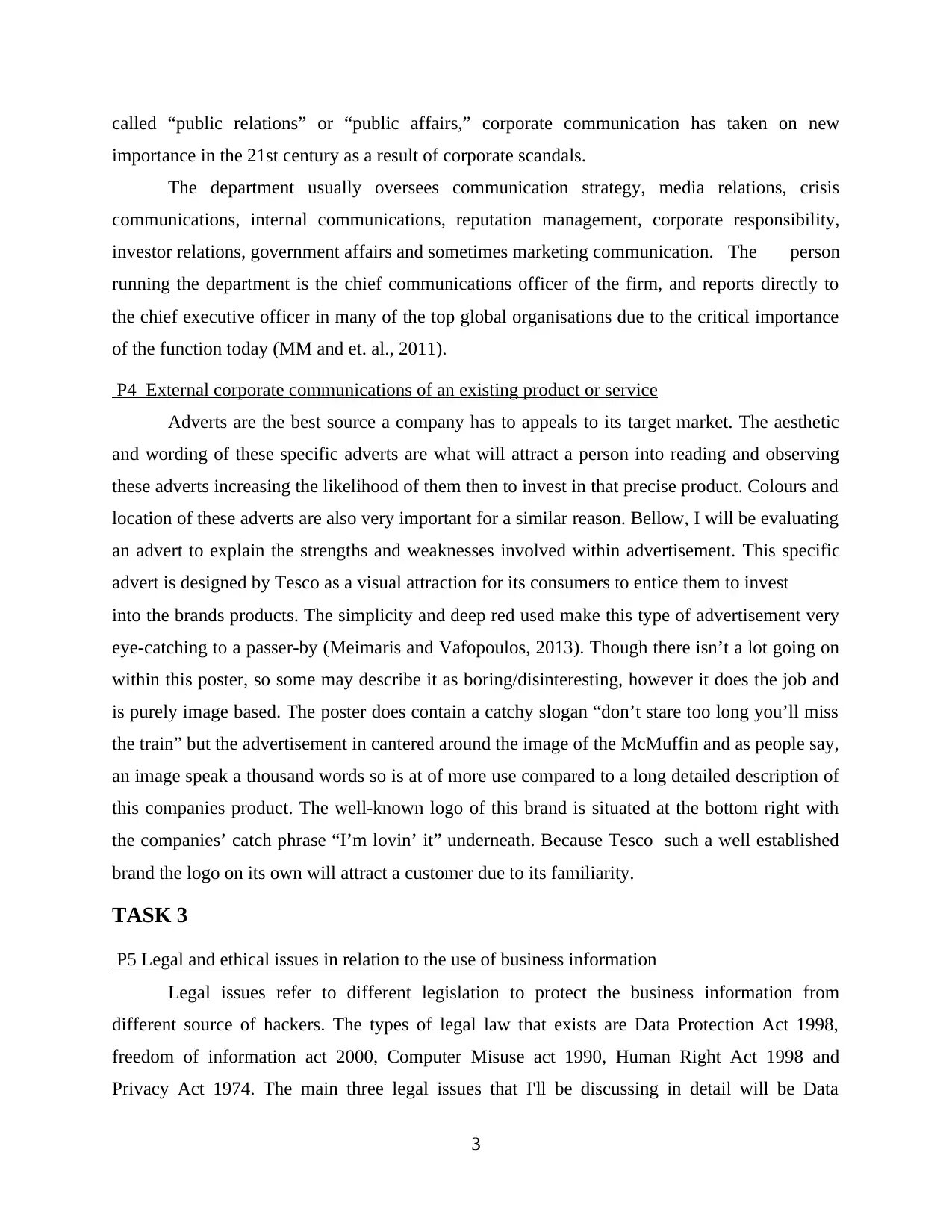
called “public relations” or “public affairs,” corporate communication has taken on new
importance in the 21st century as a result of corporate scandals.
The department usually oversees communication strategy, media relations, crisis
communications, internal communications, reputation management, corporate responsibility,
investor relations, government affairs and sometimes marketing communication. The person
running the department is the chief communications officer of the firm, and reports directly to
the chief executive officer in many of the top global organisations due to the critical importance
of the function today (MM and et. al., 2011).
P4 External corporate communications of an existing product or service
Adverts are the best source a company has to appeals to its target market. The aesthetic
and wording of these specific adverts are what will attract a person into reading and observing
these adverts increasing the likelihood of them then to invest in that precise product. Colours and
location of these adverts are also very important for a similar reason. Bellow, I will be evaluating
an advert to explain the strengths and weaknesses involved within advertisement. This specific
advert is designed by Tesco as a visual attraction for its consumers to entice them to invest
into the brands products. The simplicity and deep red used make this type of advertisement very
eye-catching to a passer-by (Meimaris and Vafopoulos, 2013). Though there isn’t a lot going on
within this poster, so some may describe it as boring/disinteresting, however it does the job and
is purely image based. The poster does contain a catchy slogan “don’t stare too long you’ll miss
the train” but the advertisement in cantered around the image of the McMuffin and as people say,
an image speak a thousand words so is at of more use compared to a long detailed description of
this companies product. The well-known logo of this brand is situated at the bottom right with
the companies’ catch phrase “I’m lovin’ it” underneath. Because Tesco such a well established
brand the logo on its own will attract a customer due to its familiarity.
TASK 3
P5 Legal and ethical issues in relation to the use of business information
Legal issues refer to different legislation to protect the business information from
different source of hackers. The types of legal law that exists are Data Protection Act 1998,
freedom of information act 2000, Computer Misuse act 1990, Human Right Act 1998 and
Privacy Act 1974. The main three legal issues that I'll be discussing in detail will be Data
3
importance in the 21st century as a result of corporate scandals.
The department usually oversees communication strategy, media relations, crisis
communications, internal communications, reputation management, corporate responsibility,
investor relations, government affairs and sometimes marketing communication. The person
running the department is the chief communications officer of the firm, and reports directly to
the chief executive officer in many of the top global organisations due to the critical importance
of the function today (MM and et. al., 2011).
P4 External corporate communications of an existing product or service
Adverts are the best source a company has to appeals to its target market. The aesthetic
and wording of these specific adverts are what will attract a person into reading and observing
these adverts increasing the likelihood of them then to invest in that precise product. Colours and
location of these adverts are also very important for a similar reason. Bellow, I will be evaluating
an advert to explain the strengths and weaknesses involved within advertisement. This specific
advert is designed by Tesco as a visual attraction for its consumers to entice them to invest
into the brands products. The simplicity and deep red used make this type of advertisement very
eye-catching to a passer-by (Meimaris and Vafopoulos, 2013). Though there isn’t a lot going on
within this poster, so some may describe it as boring/disinteresting, however it does the job and
is purely image based. The poster does contain a catchy slogan “don’t stare too long you’ll miss
the train” but the advertisement in cantered around the image of the McMuffin and as people say,
an image speak a thousand words so is at of more use compared to a long detailed description of
this companies product. The well-known logo of this brand is situated at the bottom right with
the companies’ catch phrase “I’m lovin’ it” underneath. Because Tesco such a well established
brand the logo on its own will attract a customer due to its familiarity.
TASK 3
P5 Legal and ethical issues in relation to the use of business information
Legal issues refer to different legislation to protect the business information from
different source of hackers. The types of legal law that exists are Data Protection Act 1998,
freedom of information act 2000, Computer Misuse act 1990, Human Right Act 1998 and
Privacy Act 1974. The main three legal issues that I'll be discussing in detail will be Data
3
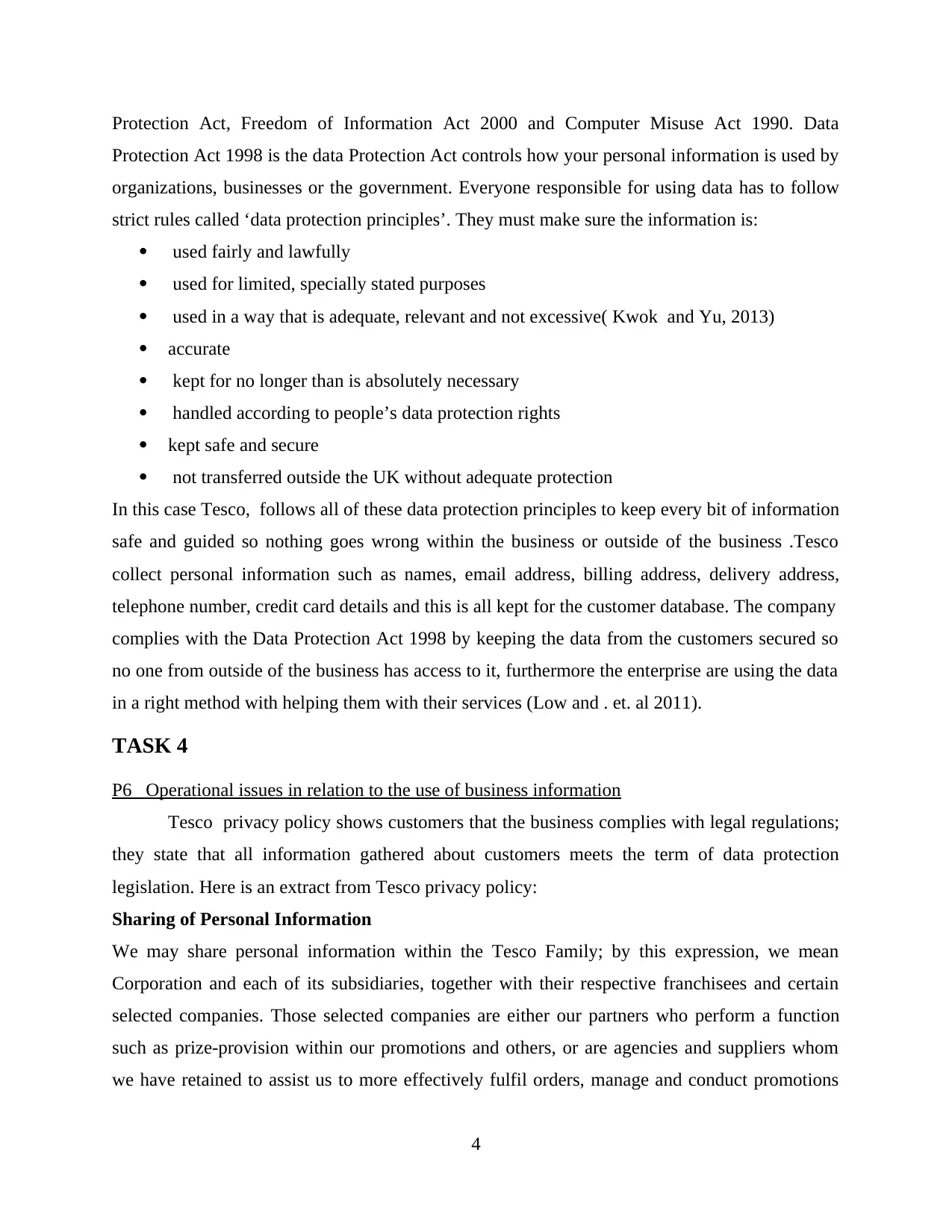
Protection Act, Freedom of Information Act 2000 and Computer Misuse Act 1990. Data
Protection Act 1998 is the data Protection Act controls how your personal information is used by
organizations, businesses or the government. Everyone responsible for using data has to follow
strict rules called ‘data protection principles’. They must make sure the information is:
used fairly and lawfully
used for limited, specially stated purposes
used in a way that is adequate, relevant and not excessive( Kwok and Yu, 2013)
accurate
kept for no longer than is absolutely necessary
handled according to people’s data protection rights
kept safe and secure
not transferred outside the UK without adequate protection
In this case Tesco, follows all of these data protection principles to keep every bit of information
safe and guided so nothing goes wrong within the business or outside of the business .Tesco
collect personal information such as names, email address, billing address, delivery address,
telephone number, credit card details and this is all kept for the customer database. The company
complies with the Data Protection Act 1998 by keeping the data from the customers secured so
no one from outside of the business has access to it, furthermore the enterprise are using the data
in a right method with helping them with their services (Low and . et. al 2011).
TASK 4
P6 Operational issues in relation to the use of business information
Tesco privacy policy shows customers that the business complies with legal regulations;
they state that all information gathered about customers meets the term of data protection
legislation. Here is an extract from Tesco privacy policy:
Sharing of Personal Information
We may share personal information within the Tesco Family; by this expression, we mean
Corporation and each of its subsidiaries, together with their respective franchisees and certain
selected companies. Those selected companies are either our partners who perform a function
such as prize-provision within our promotions and others, or are agencies and suppliers whom
we have retained to assist us to more effectively fulfil orders, manage and conduct promotions
4
Protection Act 1998 is the data Protection Act controls how your personal information is used by
organizations, businesses or the government. Everyone responsible for using data has to follow
strict rules called ‘data protection principles’. They must make sure the information is:
used fairly and lawfully
used for limited, specially stated purposes
used in a way that is adequate, relevant and not excessive( Kwok and Yu, 2013)
accurate
kept for no longer than is absolutely necessary
handled according to people’s data protection rights
kept safe and secure
not transferred outside the UK without adequate protection
In this case Tesco, follows all of these data protection principles to keep every bit of information
safe and guided so nothing goes wrong within the business or outside of the business .Tesco
collect personal information such as names, email address, billing address, delivery address,
telephone number, credit card details and this is all kept for the customer database. The company
complies with the Data Protection Act 1998 by keeping the data from the customers secured so
no one from outside of the business has access to it, furthermore the enterprise are using the data
in a right method with helping them with their services (Low and . et. al 2011).
TASK 4
P6 Operational issues in relation to the use of business information
Tesco privacy policy shows customers that the business complies with legal regulations;
they state that all information gathered about customers meets the term of data protection
legislation. Here is an extract from Tesco privacy policy:
Sharing of Personal Information
We may share personal information within the Tesco Family; by this expression, we mean
Corporation and each of its subsidiaries, together with their respective franchisees and certain
selected companies. Those selected companies are either our partners who perform a function
such as prize-provision within our promotions and others, or are agencies and suppliers whom
we have retained to assist us to more effectively fulfil orders, manage and conduct promotions
4
⊘ This is a preview!⊘
Do you want full access?
Subscribe today to unlock all pages.

Trusted by 1+ million students worldwide
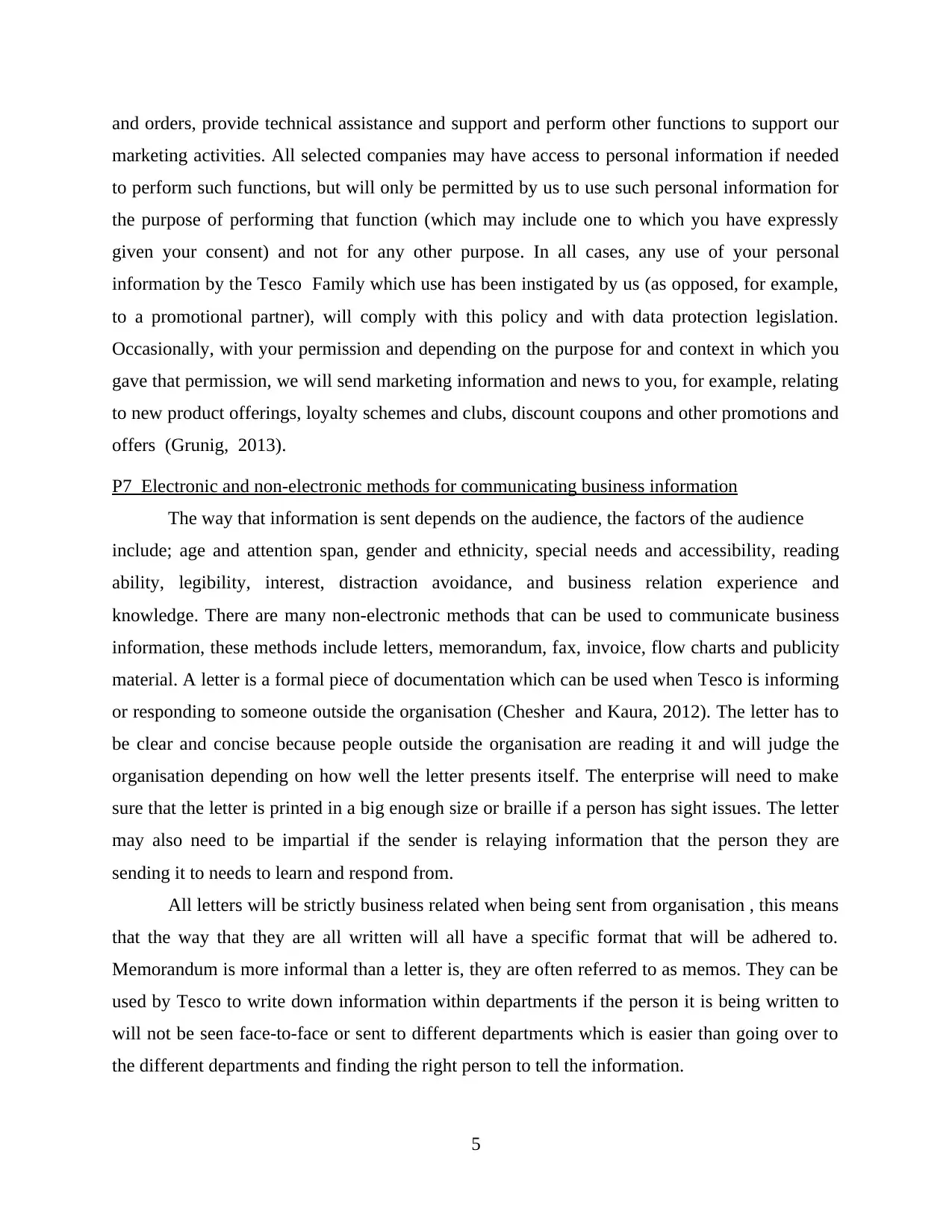
and orders, provide technical assistance and support and perform other functions to support our
marketing activities. All selected companies may have access to personal information if needed
to perform such functions, but will only be permitted by us to use such personal information for
the purpose of performing that function (which may include one to which you have expressly
given your consent) and not for any other purpose. In all cases, any use of your personal
information by the Tesco Family which use has been instigated by us (as opposed, for example,
to a promotional partner), will comply with this policy and with data protection legislation.
Occasionally, with your permission and depending on the purpose for and context in which you
gave that permission, we will send marketing information and news to you, for example, relating
to new product offerings, loyalty schemes and clubs, discount coupons and other promotions and
offers (Grunig, 2013).
P7 Electronic and non-electronic methods for communicating business information
The way that information is sent depends on the audience, the factors of the audience
include; age and attention span, gender and ethnicity, special needs and accessibility, reading
ability, legibility, interest, distraction avoidance, and business relation experience and
knowledge. There are many non-electronic methods that can be used to communicate business
information, these methods include letters, memorandum, fax, invoice, flow charts and publicity
material. A letter is a formal piece of documentation which can be used when Tesco is informing
or responding to someone outside the organisation (Chesher and Kaura, 2012). The letter has to
be clear and concise because people outside the organisation are reading it and will judge the
organisation depending on how well the letter presents itself. The enterprise will need to make
sure that the letter is printed in a big enough size or braille if a person has sight issues. The letter
may also need to be impartial if the sender is relaying information that the person they are
sending it to needs to learn and respond from.
All letters will be strictly business related when being sent from organisation , this means
that the way that they are all written will all have a specific format that will be adhered to.
Memorandum is more informal than a letter is, they are often referred to as memos. They can be
used by Tesco to write down information within departments if the person it is being written to
will not be seen face-to-face or sent to different departments which is easier than going over to
the different departments and finding the right person to tell the information.
5
marketing activities. All selected companies may have access to personal information if needed
to perform such functions, but will only be permitted by us to use such personal information for
the purpose of performing that function (which may include one to which you have expressly
given your consent) and not for any other purpose. In all cases, any use of your personal
information by the Tesco Family which use has been instigated by us (as opposed, for example,
to a promotional partner), will comply with this policy and with data protection legislation.
Occasionally, with your permission and depending on the purpose for and context in which you
gave that permission, we will send marketing information and news to you, for example, relating
to new product offerings, loyalty schemes and clubs, discount coupons and other promotions and
offers (Grunig, 2013).
P7 Electronic and non-electronic methods for communicating business information
The way that information is sent depends on the audience, the factors of the audience
include; age and attention span, gender and ethnicity, special needs and accessibility, reading
ability, legibility, interest, distraction avoidance, and business relation experience and
knowledge. There are many non-electronic methods that can be used to communicate business
information, these methods include letters, memorandum, fax, invoice, flow charts and publicity
material. A letter is a formal piece of documentation which can be used when Tesco is informing
or responding to someone outside the organisation (Chesher and Kaura, 2012). The letter has to
be clear and concise because people outside the organisation are reading it and will judge the
organisation depending on how well the letter presents itself. The enterprise will need to make
sure that the letter is printed in a big enough size or braille if a person has sight issues. The letter
may also need to be impartial if the sender is relaying information that the person they are
sending it to needs to learn and respond from.
All letters will be strictly business related when being sent from organisation , this means
that the way that they are all written will all have a specific format that will be adhered to.
Memorandum is more informal than a letter is, they are often referred to as memos. They can be
used by Tesco to write down information within departments if the person it is being written to
will not be seen face-to-face or sent to different departments which is easier than going over to
the different departments and finding the right person to tell the information.
5
Paraphrase This Document
Need a fresh take? Get an instant paraphrase of this document with our AI Paraphraser
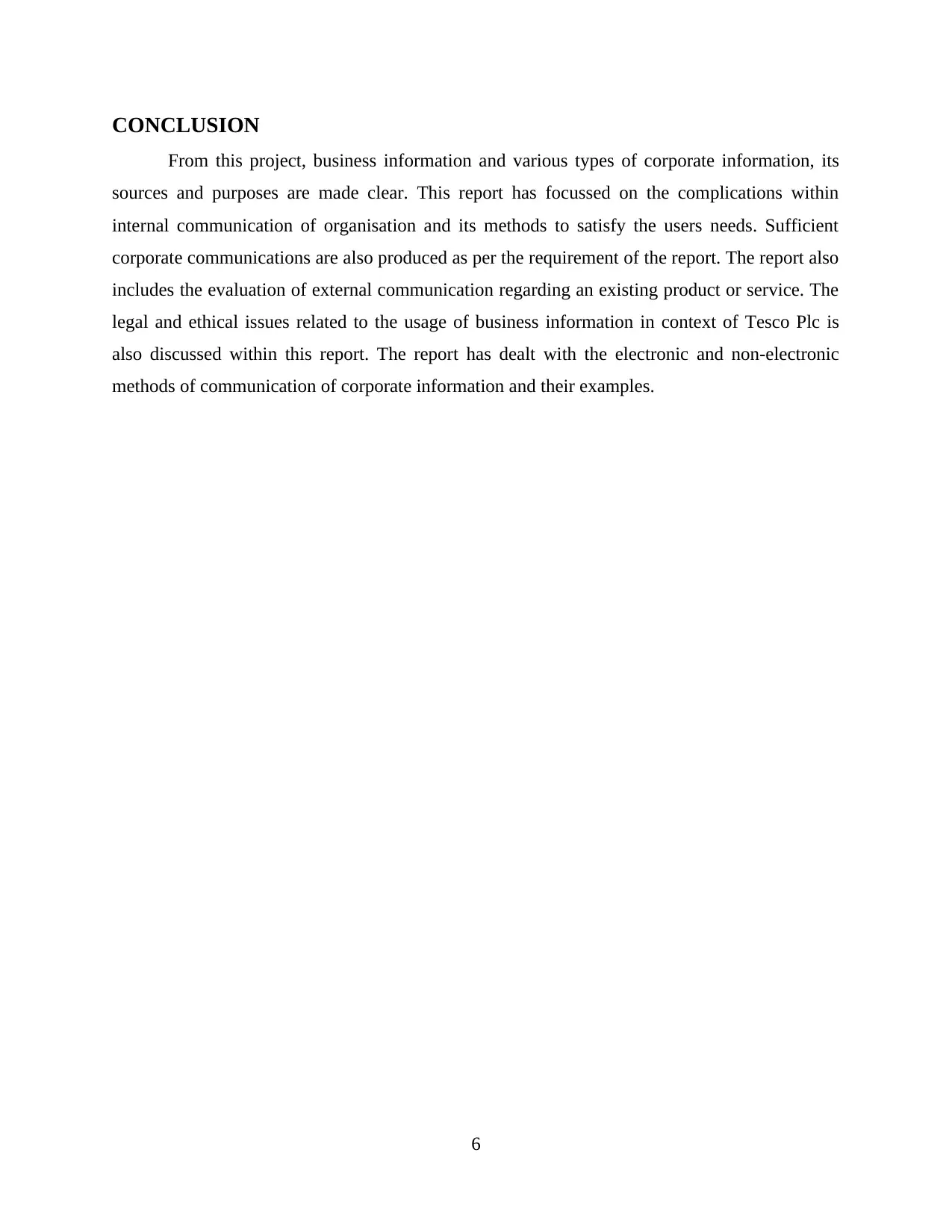
CONCLUSION
From this project, business information and various types of corporate information, its
sources and purposes are made clear. This report has focussed on the complications within
internal communication of organisation and its methods to satisfy the users needs. Sufficient
corporate communications are also produced as per the requirement of the report. The report also
includes the evaluation of external communication regarding an existing product or service. The
legal and ethical issues related to the usage of business information in context of Tesco Plc is
also discussed within this report. The report has dealt with the electronic and non-electronic
methods of communication of corporate information and their examples.
6
From this project, business information and various types of corporate information, its
sources and purposes are made clear. This report has focussed on the complications within
internal communication of organisation and its methods to satisfy the users needs. Sufficient
corporate communications are also produced as per the requirement of the report. The report also
includes the evaluation of external communication regarding an existing product or service. The
legal and ethical issues related to the usage of business information in context of Tesco Plc is
also discussed within this report. The report has dealt with the electronic and non-electronic
methods of communication of corporate information and their examples.
6
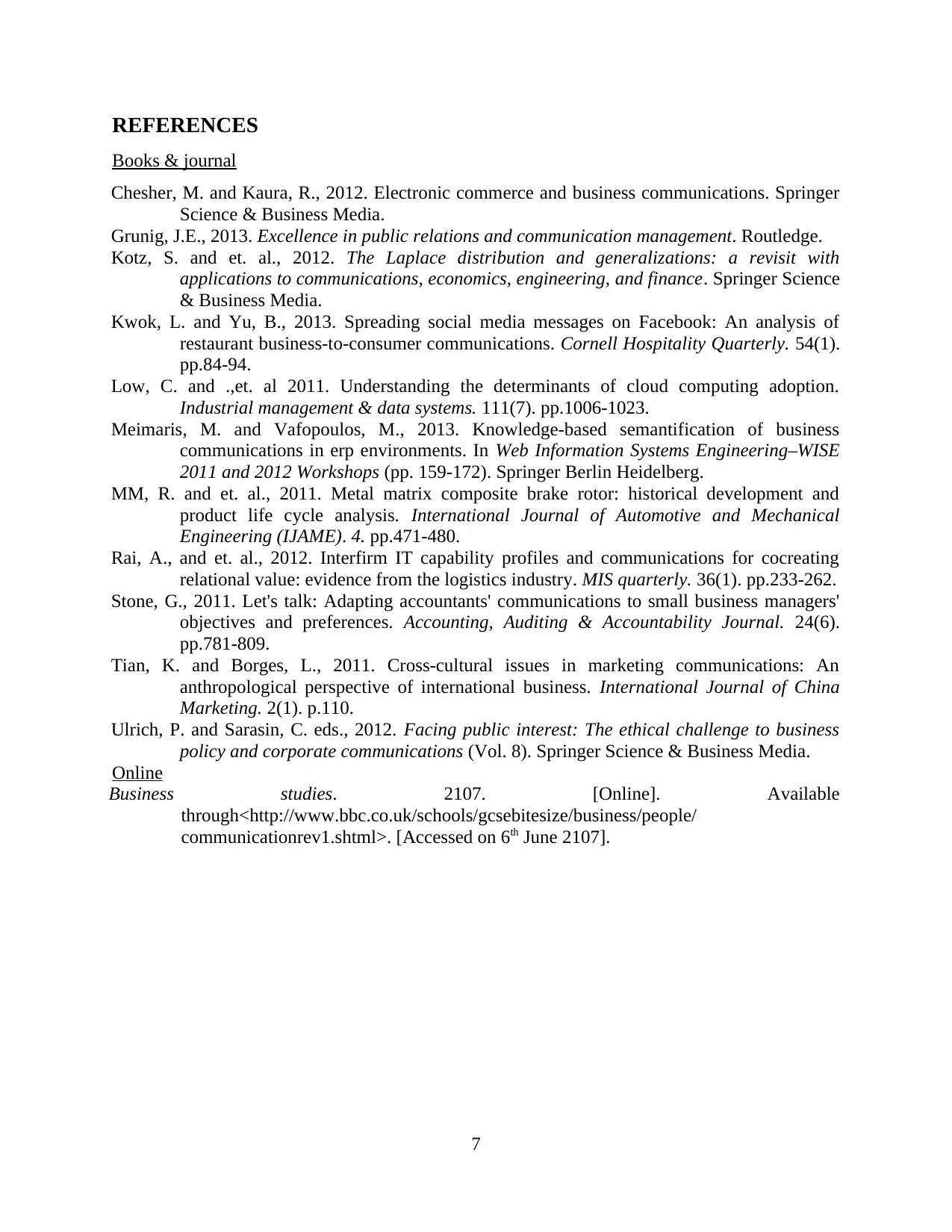
REFERENCES
Books & journal
Chesher, M. and Kaura, R., 2012. Electronic commerce and business communications. Springer
Science & Business Media.
Grunig, J.E., 2013. Excellence in public relations and communication management. Routledge.
Kotz, S. and et. al., 2012. The Laplace distribution and generalizations: a revisit with
applications to communications, economics, engineering, and finance. Springer Science
& Business Media.
Kwok, L. and Yu, B., 2013. Spreading social media messages on Facebook: An analysis of
restaurant business-to-consumer communications. Cornell Hospitality Quarterly. 54(1).
pp.84-94.
Low, C. and .,et. al 2011. Understanding the determinants of cloud computing adoption.
Industrial management & data systems. 111(7). pp.1006-1023.
Meimaris, M. and Vafopoulos, M., 2013. Knowledge-based semantification of business
communications in erp environments. In Web Information Systems Engineering–WISE
2011 and 2012 Workshops (pp. 159-172). Springer Berlin Heidelberg.
MM, R. and et. al., 2011. Metal matrix composite brake rotor: historical development and
product life cycle analysis. International Journal of Automotive and Mechanical
Engineering (IJAME). 4. pp.471-480.
Rai, A., and et. al., 2012. Interfirm IT capability profiles and communications for cocreating
relational value: evidence from the logistics industry. MIS quarterly. 36(1). pp.233-262.
Stone, G., 2011. Let's talk: Adapting accountants' communications to small business managers'
objectives and preferences. Accounting, Auditing & Accountability Journal. 24(6).
pp.781-809.
Tian, K. and Borges, L., 2011. Cross-cultural issues in marketing communications: An
anthropological perspective of international business. International Journal of China
Marketing. 2(1). p.110.
Ulrich, P. and Sarasin, C. eds., 2012. Facing public interest: The ethical challenge to business
policy and corporate communications (Vol. 8). Springer Science & Business Media.
Online
Business studies. 2107. [Online]. Available
through<http://www.bbc.co.uk/schools/gcsebitesize/business/people/
communicationrev1.shtml>. [Accessed on 6th June 2107].
7
Books & journal
Chesher, M. and Kaura, R., 2012. Electronic commerce and business communications. Springer
Science & Business Media.
Grunig, J.E., 2013. Excellence in public relations and communication management. Routledge.
Kotz, S. and et. al., 2012. The Laplace distribution and generalizations: a revisit with
applications to communications, economics, engineering, and finance. Springer Science
& Business Media.
Kwok, L. and Yu, B., 2013. Spreading social media messages on Facebook: An analysis of
restaurant business-to-consumer communications. Cornell Hospitality Quarterly. 54(1).
pp.84-94.
Low, C. and .,et. al 2011. Understanding the determinants of cloud computing adoption.
Industrial management & data systems. 111(7). pp.1006-1023.
Meimaris, M. and Vafopoulos, M., 2013. Knowledge-based semantification of business
communications in erp environments. In Web Information Systems Engineering–WISE
2011 and 2012 Workshops (pp. 159-172). Springer Berlin Heidelberg.
MM, R. and et. al., 2011. Metal matrix composite brake rotor: historical development and
product life cycle analysis. International Journal of Automotive and Mechanical
Engineering (IJAME). 4. pp.471-480.
Rai, A., and et. al., 2012. Interfirm IT capability profiles and communications for cocreating
relational value: evidence from the logistics industry. MIS quarterly. 36(1). pp.233-262.
Stone, G., 2011. Let's talk: Adapting accountants' communications to small business managers'
objectives and preferences. Accounting, Auditing & Accountability Journal. 24(6).
pp.781-809.
Tian, K. and Borges, L., 2011. Cross-cultural issues in marketing communications: An
anthropological perspective of international business. International Journal of China
Marketing. 2(1). p.110.
Ulrich, P. and Sarasin, C. eds., 2012. Facing public interest: The ethical challenge to business
policy and corporate communications (Vol. 8). Springer Science & Business Media.
Online
Business studies. 2107. [Online]. Available
through<http://www.bbc.co.uk/schools/gcsebitesize/business/people/
communicationrev1.shtml>. [Accessed on 6th June 2107].
7
⊘ This is a preview!⊘
Do you want full access?
Subscribe today to unlock all pages.

Trusted by 1+ million students worldwide
1 out of 9
Related Documents
Your All-in-One AI-Powered Toolkit for Academic Success.
+13062052269
info@desklib.com
Available 24*7 on WhatsApp / Email
![[object Object]](/_next/static/media/star-bottom.7253800d.svg)
Unlock your academic potential
Copyright © 2020–2025 A2Z Services. All Rights Reserved. Developed and managed by ZUCOL.





